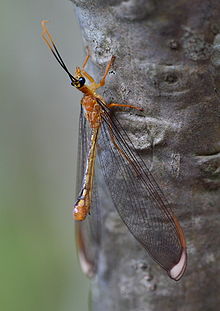- Nymphes myrmeleonides
-
Nymphes myrmeleonides 
Scientific classification Kingdom: Animalia Phylum: Arthropoda Class: Insecta Order: Neuroptera Family: Nymphidae Genus: Nymphes Species: N. myrmeleonides Binomial name Nymphes myrmeleonides
Leach, 1814 [1]Nymphes myrmeleonides is an Australian lacewing, known as the blue eyes lacewing.[2] It is found in areas of New South Wales and Queensland,[3] and is one of the largest lacewings in the world.[4] The species have a body length of up to 4 centimetres (1.6 in) and a wingspan of up to 11 cm (4.3 in), each wing ending in a white tip.[5] The larvae of N. myrmeleonides resemble antlions and construct pit traps by burrowing into loose soil.[6]
References
- ^ "Planiupennia in the Swedish Museum of Natural History". Naturhistoriska riksmuseet. August 24, 2000. http://www2.nrm.se/en/neurop.html.
- ^ "Blue eyes lacewing — Nymphes myrmeleonides". Brisbane Insects and Spiders. December 30, 2005. Archived from the original on October 25, 2009. http://www.webcitation.org/query?url=http://www.geocities.com/brisbane_lacewings/BlueEyes.htm&date=2009-10-25+16:37:00.
- ^ "Nymphes myrmeleonides". Zipcode Zoo. April 5, 2007. http://zipcodezoo.com/Animals/N/Nymphes_myrmeleonides.asp.
- ^ Heather Proctor (June 14, 2004). "Giant lacewing (Neuroptera: Nymphidae)". University of Alberta. http://bio-ditrl.sunsite.ualberta.ca/detail/?P_MNO=5221.
- ^ "Lacewing development". University of Sydney. June 10, 2006. http://bugs.bio.usyd.edu.au/Entomology/lifeCycles/imagePages/lacewingDevpmnt.html.
- ^ "Nymphes myrmeleonides". Botanic Gardens Trust. http://www.rbgsyd.nsw.gov.au/conservation_research/ecology_research/Ecology_of_Cumberland_Plain_Woodland/woodland_wildlife/invertebrate_animals/nymphes_myrmeleoides. Retrieved April 17, 2007.
This Neuroptera related article is a stub. You can help Wikipedia by expanding it.
